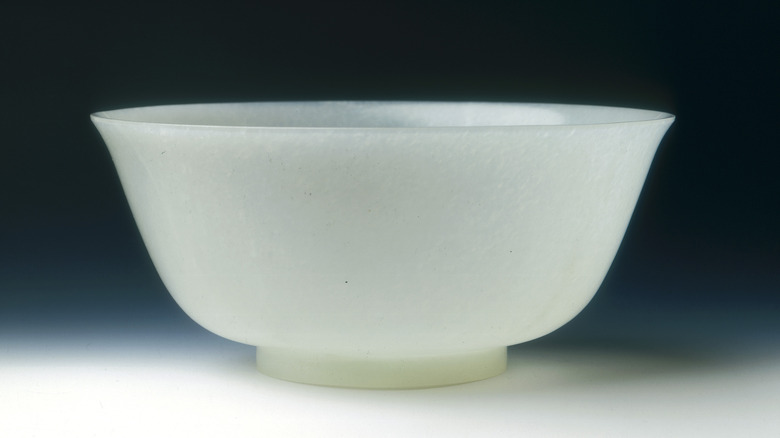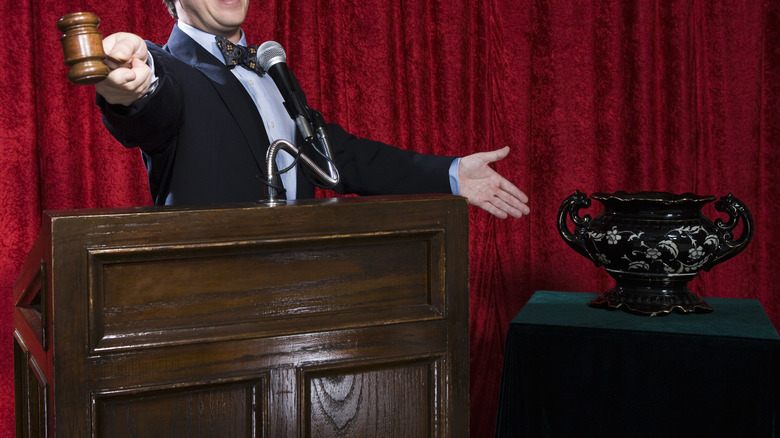What Happened To The 18th-Century Jade Bowl From Antiques Roadshow?
Those who scour flea markets, tag sales, or go "antiquing" for relics of the past will likely agree: Most stuff is trash. People prowl warehouses, tents, or rows of outdoor tables in search of kitsch that will maybe look good on a shelf, or a pair of not-too-rusty earrings that an aunt might like for her next birthday. And how much could a seller of such wares realistically expect to get? $5.75 on a good afternoon? And yet, miracles do happen. Such wonders propel the antiquities industry forward and give others hope that maybe, just maybe, that junk in the basement will be "worth something someday."
This is exactly what happened to Jinx Taylor back in 2009 on Season 14, Episode 1 of the mannerly and good-natured PBS series, "Antiques Roadshow." Much like other people looking to sell antique goods, Taylor brought a family story with her items. Her military father had been stationed somewhere in China "in the late '30s and sometime during the '40s," she said, where he befriended a "Mr. Liang at No. 10 Jade Street." This Mr. Liang not only beckoned Taylor's father to look at his jade collection — some of which were imprinted with imperial seals— but passed some of it to him.
Come 2009, "Antiques Roadshow" appraiser James Callahan valued Taylor's collection of jade hand-me-downs —including a unique white bowl — at $710,000 to $1,070,000, one of the show's all-time highs. But as Current said the following year, the items sold for much less: $494,615.
Dashed dreams of greater cash
Granted, $494,615 isn't exactly a small chunk of money. And yet, given James Callahan's valuation of Jinx Taylor's jadeware collection, AOL reports that he told Maine Antiques Digest he was "disappointed" by the amount. Looking to her and Callahan's original discussion on PBS, she was absolutely gobsmacked as Callahan appraised each of her four items at higher and higher values: $30,000 to $50,000 (a bowl), $80,000 to $120,000 (the vase), $200,000 to $300,000 (the dragon), and $400,000 to $600,000 (the other bowl with an imperial inscription). This valuation gave Taylor high hopes that ultimately weren't fulfilled.
Each item dated to China's Qing dynasty (1644 to 1911 C.E.) during the reign of the Qianlong emperor (1735 to 1796 C.E.) in a "golden age of China," as the National Gallery of Victoria puts it. The collection was Moghul in design, Callahan said, a style imported from India's Moghul emperors circa the 16th to 17th centuries. It was the smaller bowl in the collection — the "runt of the litter," he said — that first caught his attention, particularly its thinness and "crisp workmanship." For those interested in more details, a full transcription of Callahan and Taylor's conversation is available on the website of antiquities dealer Roger Schwendeman.
The auction site Christie's says that out of all the periods of Chinese jadeware, some regard items from the Qing dynasty as the highest in quality, particularly the more delicate pieces like the small bowl in Jinx Taylor's collection.
More money, more disappointments
We don't have any details about who bought Jinx Taylor's four-piece jadeware collection that she first proffered on "Antiques Roadshow" in 2009. We also don't know if that individual or group has kept the collection or passed it along to some other person or institution. We also don't know what Taylor has been up to since her sale, although we can at least say that she's been more financially comfortable.
Aside from the four-piece collection that James Callahan evaluated on air, Current says that Taylor had an additional 30 pieces in the full collection that she inherited from her father. She also sold these other 30 pieces off the air for an additional $350,523. Considering the distribution of money between the four "Antiques Roadshow" items and the 30 other items, we can assume that the little bowl, the vase, the dragon, and the bigger bowl that appeared on the PBS show were the most impressive of the bunch.
Interestingly enough, Taylor's jade collection isn't the only collection of items from China's Qing dynasty to find its way into "Antiques Roadshow," or even the highest valuation of such items. In 2011, two years after Taylor's collection made it onto the show, The Washington Post reported one Douglas Huber receiving an estimate of $1 to $1.5 million total for five cups made from rhinoceros horns. As the New York Post later reported, these items also underperformed at auction. Only two sold, one for $146,500, and the other for $182,500.


